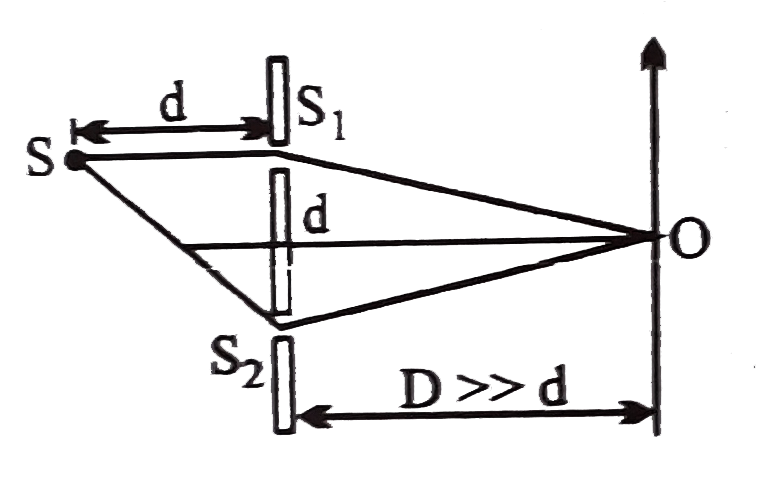A thin mica sheet of thickness 2×10−6m and refractive index (μ=1.5) is introduced in the path of the first wave. The wavelength of the wave used is 5000Å. The central bright maximum will shift
two fringes upward
two fringes downward
ten fringes upward
None of these
The correct Answer is:A
To solve the problem of finding the shift in the central bright maximum when a thin mica sheet is introduced, we can follow these steps:
1. Identify the Given Values:
- Thickness of the mica sheet, t=2×10−6m
- Refractive index of the mica sheet, μ=1.5
- Wavelength of the wave, λ=5000Å=5000×10−10m
2. Understand the Concept of Fringe Shift:
- When a thin film (like the mica sheet) is introduced in the path of one of the waves in an interference pattern, it causes a shift in the interference fringes.
- The formula for the fringe shift (in terms of the number of fringes shifted) is given by:
Shift=t(μ−1)λ
- Here, t is the thickness of the film, μ is the refractive index, and λ is the wavelength of the light used.
3. Substitute the Values into the Formula:
- Substitute the given values into the formula:
Shift=(2×10−6)×(1.5−1)5000×10−10
- Simplifying the expression:
Shift=(2×10−6)×(0.5)5000×10−10=1×10−65000×10−10
4. Calculate the Shift:
- Calculate the denominator:
5000×10−10=5×10−7
- Now, calculate the shift:
Shift=1×10−65×10−7=2
5. Interpret the Result:
- The result indicates that the central bright maximum shifts by 2 fringes upward.
Final Answer:
The central bright maximum will shift 2 fringes upward.
---
- Thickness of the mica sheet, t=2×10−6m
- Refractive index of the mica sheet, μ=1.5
- Wavelength of the wave, λ=5000Å=5000×10−10m
- When a thin film (like the mica sheet) is introduced in the path of one of the waves in an interference pattern, it causes a shift in the interference fringes.
- The formula for the fringe shift (in terms of the number of fringes shifted) is given by:
Shift=t(μ−1)λ
- Here, t is the thickness of the film, μ is the refractive index, and λ is the wavelength of the light used.
- Substitute the given values into the formula:
Shift=(2×10−6)×(1.5−1)5000×10−10
- Simplifying the expression:
Shift=(2×10−6)×(0.5)5000×10−10=1×10−65000×10−10
- Calculate the denominator:
5000×10−10=5×10−7
- Now, calculate the shift:
Shift=1×10−65×10−7=2
- The result indicates that the central bright maximum shifts by 2 fringes upward.
The central bright maximum will shift 2 fringes upward.
Topper's Solved these Questions
- WAVE OPTICSBOOK - DC PANDEY ENGLISHCHAPTER - WAVE OPTICSEXERCISE - taking it together
47 Videos
- WAVE OPTICSBOOK - DC PANDEY ENGLISHCHAPTER - WAVE OPTICSEXERCISE - Assertion reason
8 Videos
- WAVE OPTICSBOOK - DC PANDEY ENGLISHCHAPTER - WAVE OPTICSEXERCISE - For JEE Advanced E. Integer Type Questions
13 Videos
- SOLVED PAPERS 2018BOOK - DC PANDEY ENGLISHCHAPTER - SOLVED PAPERS 2018EXERCISE - JIPMER
22 Videos
Similar Questions
A thin mica sheet of thickness 4×10−6 m and refractive index (μ=1.5) is introduced in the path of the light from upper slit. The wavelength of the wave used is 5000Å The central bright maximum will shift
View SolutionA double slit experiment is performed with light of wavelength 500nm. A thin film of thickness 2μm and refractive index 1.5 is introduced in the path of the upper beam. The location of the central maximum will
View SolutionIf a thin mica sheet of thickness 't' and refractive index μ is placed in the path of one of the waves producing interference , then the whole interference pattern shifts towards the side of the sheet by a distance
View SolutionInterference fringes were produced using light in a doulbe-slit experiment. When a mica sheet of uniform thickness and refractive index 1.6 (relative to air) is placed in the path of light from one of the slits, the central fringe moves through some distance. This distance is equal to the width of 30 interference bands if light of wavelength 4800 is used. The thickness (in μm) of mica is
View SolutionIn YDSE using monochromatic light, the fringe pattern shifts by a certain distance on the screen when a mica sheet of refractive index 1.5 and thickness 2 microns is introduced in the path of one of the interfering waves. The mica sheet is then removed and the distance between the plane of slits and the screen is doubled. It is found that the distance between successive maxima (or minima) now is the same as the observed fringe shift upon the introduction of the mica sheet. Calculate the wavelength of the light.
View SolutionTo make the central fringe at the centerO , mica sheet of refractive index 1.5 is introduced Choose the corect statement.

View SolutionIn a doulble slit experiment when a thin film of thickness t having refractive index μ is introduced in from of one of the slits, the maximum at the centre of the fringe pattern shifts by one width. The value of t is (λ is the wavelength of the light used)
View SolutionIn the ideal double-slit experiment, when a glass-plate (refractive index 1.5) of thickness t is introduced in the path of one of the interfering beams (wavelength λ), the intensity at the position where the central maximum occurred previously remains unchanged. The minimum thickness of the glass-plate is
View SolutionIn the ideal double-slit experiment, when a glass-plate (refractive index 1.5) of thickness t is introduced in the path of one of the interfering beams (wavelength λ), the intensity at the position where the central maximum occurred previously remains unchanged. The minimum thickness of the glass-plate is
View SolutionThe central fringe shifts to the position of fifth bright fringe, if a thin film of refractive index 1.5 is introduced in the path of light of wavelength 5000Å. The thickness of the glass plate is
View Solution
